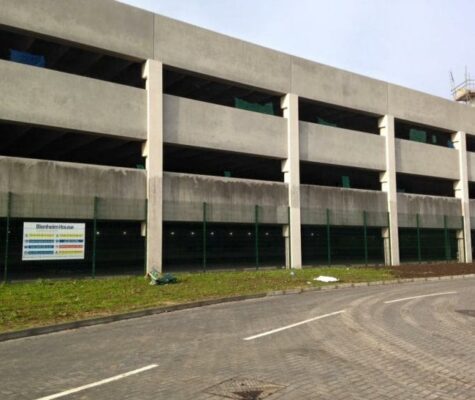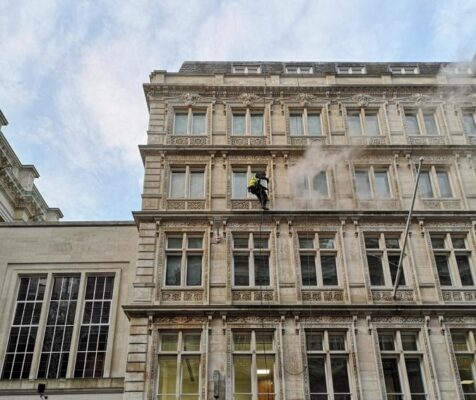View More SErvices Contact Us
Facade Cleaning in Kennington
Cleaning building facades from top to bottom, no matter how tall your building.
Natural stone facade cleaning in Kennington can be accessed and cleaned efficiently and effectively by using rope access methods. Using this method, the need for local authority permits is totally eradicated, allowing works to proceed immediately. Using professional stone cleaning equipment we can roll back the years to make your building look like new.
Brick cleaning
Brick buildings become dirty as much as any other building. We will not only clean away the dirt and grime, we can revitalise the colour. Using a range of bio-degradable chemicals, we can restore the colour of red or yellow bricks.
Contact UsGlass facade cleaning in Kennington
Glass facade cleaning in Kennington takes place by abseilers using traditional window cleaning tools. External windows, internal atriums, after builders cleaning or regular maintenance cleans, our abseilers are experienced in all manner of glass cleaning.
Contact UsAluminium cladding cleaning
Aluminium cladding in Kennington can become extremely dirty over time. Warehouses that have many lorries coming and going will become soiled with traffic film. Using our steam cleaning systems, this grime is washed away leaving a lasting first impression for your visitors.
Contact UsOur services
Rope Access Facade Cleaning Services for Kennington And Surrounding Counties

Residential property Stone Facade Cleaning
Façade cleaning at this residential property in Kennington, which was not of any great height but, had no access for other forms of access equipment. Abseiling was the solution and the results were outstanding.

Stone Steam Cleaning in London
This beautiful natural stone building was looking tired from the day to day London traffic. Rope access was seen as the most cost-effective method of access.

Concrete Facade Cleaning in Kennington
This car park in Essex was filthy. It hadn’t been cleaned, ever. As the access to three elevations was extremely tight, abseiling was the only method that could achieve the results.

Facade Cleaning in Kennington
A new acquisition for our client needed a freshen up. Out of hours abseiling was the best way to clean this building in the heart of the City of London.
Brick colour restoration
Before colour restoration
This client requested a test patch before assigning us the job of cleaning their building. We carried this out with amazing results.
After colour restoration
These are the pictures of the test patch that we sent to the client. Her reaction was simply ‘WOW’. That’s the perfect response for us.
Torik Stone Cleaning System Features
150 degrees centigrade steam cleaning power
Provides a continues flow of superheated water to penetrate stone and deep clean, removing organic growth & ground in dirt.
We use Tensid (uk) Ltd
Providers of specialist cleaning equipment and specialist cleaning chemicals to professionals.
Get In Touch
Fill in the form below and we’ll be in touch within 24hrs of receiving your message.
Facts About Kennington
Kennington History
Harthacnut, King of Denmark and King of England, died at Kennington in 1041. Harold Godwinson took the Crown the day after the death of Edward the Confessor at Kennington; he is said to have placed it upon his own head. King Henry III held his court here in 1231; and, according to Matthew Paris, in 1232, Parliament was held at Kennington.
Edward III gave the manor of Kennington to his oldest son Edward the Black Prince in 1337. And the prince then built a large royal palace in the triangle formed by Kennington Lane, Sancroft Street and Cardigan Street, near to Kennington Cross. In 1377, according to John Stow, John of Gaunt, 1st Duke of Lancaster came to Kennington to escape the fury of the people of London.
General Info
Edward III gave the manor of Kennington to his oldest son Edward the Black Prince in 1337. And the prince then built a large royal palace in the triangle formed by Kennington Lane, Sancroft Street and Cardigan Street, near to Kennington Cross. In 1377, according to John Stow, John of Gaunt, 1st Duke of Lancaster came to Kennington to escape the fury of the people of London.
reviously, a royal manor in the parish of St Mary, Lambeth in the county of Surrey and was the administrative centre of the parish from 1853. Proximity to central London was key to the development of the area as a residential suburb and it was incorporated into the metropolitan area of London in 1855. Kennington is the location of three significant London landmarks: the Oval cricket ground, the Imperial War Museum, and Kennington Park.



